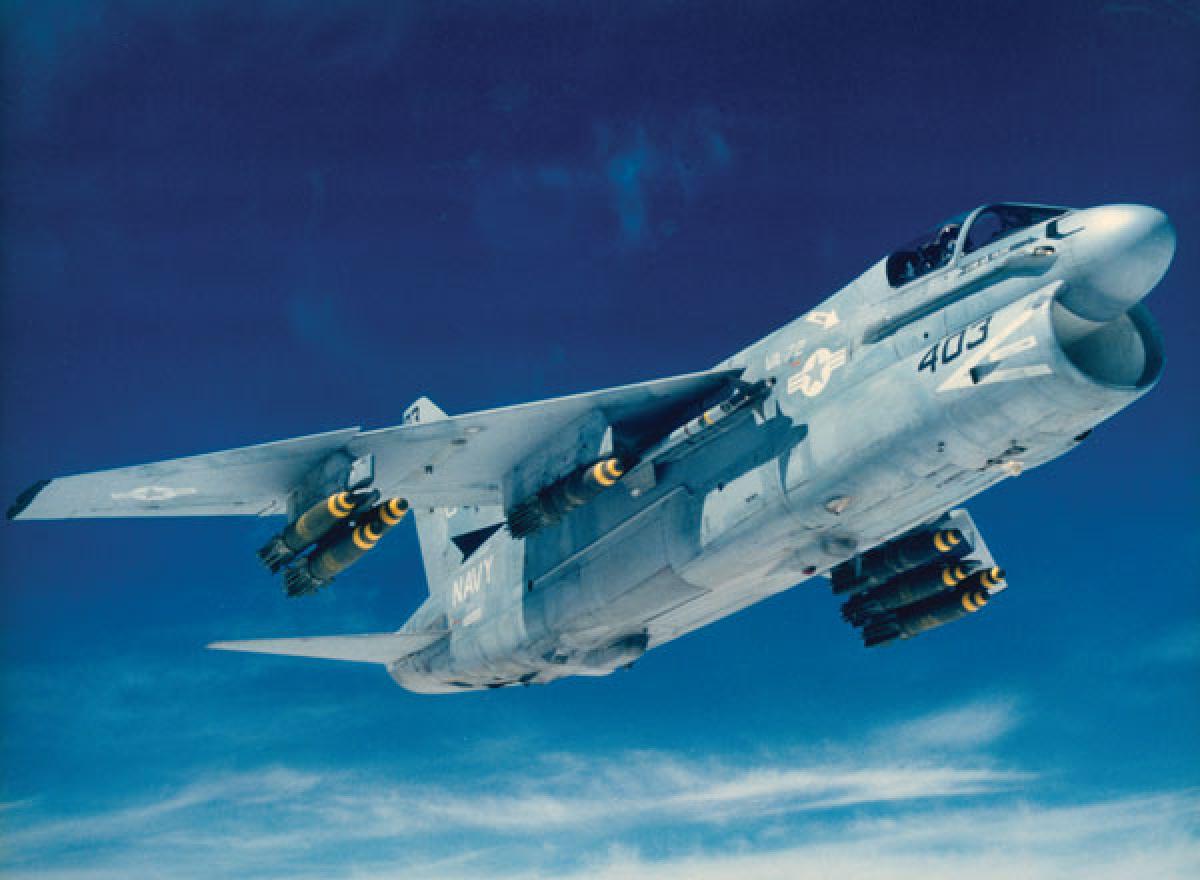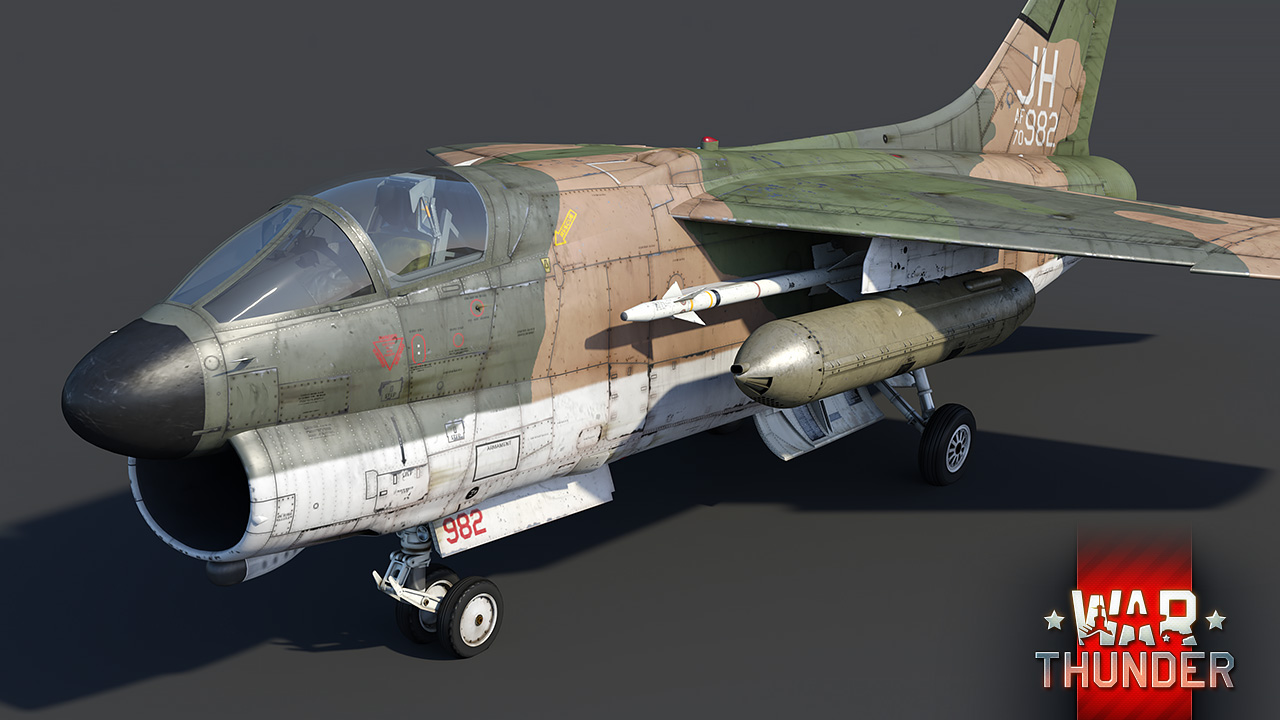A 7 Aircraft - The LTV A-7 Corsair II is a United States supersonic light attack aircraft designed and built by Ling-Temco-Vought (LTV).
The A-7 was developed in the early 1960s as a replacement for the Douglas A-4 Skyhawk. Its design was derived from the Vought F-8 Crusader. Compared to the F-8, the A-7 was smaller and limited to supersonic speeds, so its airframe was easier and cheaper to build. Following a competitive bid by Vought in response to the United States Navy's (USN) VAL (Heavier-than-air, Attack, Light) requirement. An initial contract for the type was issued on 8 February 1964. Developmt was rapid and it flew for the first time. 26 Sep 1965 and 1 Feb 1967 with USN Taring Division. That year, A-7s were deployed overseas for the Vietnam War.
A 7 Aircraft
Originally used by the USN, the A-7 proved attractive to other services and was soon adopted by the United States Air Force (USAF) and Air National Guard (ANG) to replace the aging Douglas A-1 Skyraider and the F- 100 of North America. . Super Saber Fleets. Improved models of the A-7 would be developed, usually using more powerful and larger displacement engines. Grada invasion of American A-7s. It would be used in major conflicts, including Operation El Dorado Canyon and the Gulf War. The type was also used to support the development of the Lockheed F-117 Nighthawk.
I'm Sorry, But I Think The A 7e Corsair Ii Deserves To Have Aim 9ls If It Is Currently At 10.7 Br.
The A-7 was exported to Greece in the 1970s and to Portugal in the late 1980s. The USAF and USN chose to retire their remaining examples in 1991. It was selected by the ANG in 1993 and the Portuguese Air Force in 1999. The A-7 was replaced by next-generation fighters such as the Geral Dynamics F-16 Fighting. Falcon and the McDonnell Douglas F/A-18 Hornet. The last operator, the Hellenic Air Force, retired the last A-7 aircraft in 2014.
In 1960, United States Navy (USN) officials began considering the need to replace the current fleet of Douglas A-4 Skyhawks.
At the time, it was unclear whether the A-4 would remain in production until 1979. Additionally, according to aviation writers Bill Gunston and Peter Gilchrist. Some individuals achieve supersonic speeds. Some people believe there is a need for a combat platform capable of carrying heavier payloads and flying more than its predecessor. Proposals for new fighter jets included Defense Secretary Robert McNamara urging the Navy to look into the matter.
In December 1962, the Sea-Based Air Strike Forces (SBASF) Study Group began to consider detailed performance and cost estimates on the subject.
Category:ltv A 7 Corsair Ii
The team analyzed a total of 144 hypothetical aircraft to support their findings. According to Gunston and Gilchrist, the main finding from these studies was that a supersonic aircraft would achieve supersonic performance.
Anticipating supersonic capability, the airframe is small. It can be cheaper and easier to produce. A large number of such combat platforms can be purchased from an ultrasonic component. Another advantage is that it also increases the speed of development by maintaining subsonic speeds.
Emphasis is placed on precision munitions delivery that minimizes munitions cost per target.

On 17 May 1963, these standards were incorporated into a draft requirement known as VAL (Heavier-than-air, Attack, Light).
A 7 Corsair Ii: The Swashbuckling Sluf
The Vought proposal was based on the successful F-8 Crusader fighter and had a similar configuration. However, it features a short-nosed airframe, giving the aircraft a "stubborn" look.
All bids were received by September 1963 and the evaluation process was completed in early November of that year.
On February 8, 1964, Congress authorized funding for the VAL. The program can continue. Three days later, Vought's submission was selected as the winner.
On March 19, 1964, Vought was awarded a contract by the Navy to produce the initial batch of aircraft, designated the A-7.
Ultimate Bomb Truck: Vought's A 7 Corsair Ii
In 1965, the A-7 received the name Corsair II. Vought previously produced three aircraft called the Corsair. In the 1920s they produced the O2U Corsair reconnaissance aircraft and in the 1930s the SBU Corsair reconnaissance bomber. During World War II, the company produced the successful F4U Corsair. The name Corsair II reflects the F4U Corsair, which gained a reputation as a capable fighter in World War II and the Korean War. It is intended for the same ground combat role as the aircraft of the same manufacturer.
On November 2, 1965, Vought publicly demonstrated the first batch of A-7As to 1,000 visitors. Test pilot John Conrad demonstrated the aircraft's ability to make rapid turns on a twelve-pound (230 kg) baby, carrying six 250-pound (110 kg) bombs and 230 kg bombs. A Navy spokesman credited the A-7 with the ability to drop the same weight of bombs at more than twice the maximum range of the A-4E.
The flight schedule continued at a relatively brisk pace, No significant delays or major delays were observed. According to Gunston and Gilchrist, Efforts by some Navy officials to slow the program to better adapt the A-7's electronic systems were overruled by the perceived urgency to get the type into service.

On October 14, 1966, draft planes were sent to the Navy, which formed the first squadron.
Vought A 7 Ohio Air Guard By Bagera3005 On Deviantart
The first A-7 squadrons reached operational status on 1 February 1967. They were able to begin overseas combat operations in the Vietnam War in December of that year.
Another 140 aircraft were ordered under a subsequent contract signed in September 1965. A third contract for 17 aircraft resulted in a total of 199 A-7As being produced.
Finding that the initial version was not underpowered, a large order was placed for 196 aircraft, an improved A-7B variant with a more powerful Pratt & Whitney TF30-8 engine. During 1966, additional types would be ordered for the United States Air Force (USAF), including the A-7D.
The Allison TF41-A-2, an approved derivative of the Rolls-Royce Spey engine, powered the A-7D, partly due to a lack of engines.
Us Navy A 7 Corsair Ii Units Of The Vietnam War: No. 48 (combat Aircraft)
During 1967, the Navy decided to cancel its order for the A-7B, reducing the aircraft to 257 variants.
A-7E in that place. A final model of the aircraft was determined and put into production. This variant incorporated many of the improvements of the USAF A-7D, including its TF41 engine and electronics. However, the engine was revised for slightly more thrust and the communications modified for compatibility with marine systems.
On November 25, 1968, the first A-7E made its maiden flight. A total of 535 aircraft will be produced.

Several specialized models were also developed during the 1970s and 1980s, such as the TA-7C for training and the EA-7L for electronic warfare.
Amazon.com: Hasegawa A7 D/e Corsair Ii Usaf/navy Attacker Aircraft 1/48
The LTV A-7 Corsair II is a portable supersonic attack aircraft. It is a derivative of the earlier Vought F-8 Crusader fighter. Compared to the Crusader, it is smaller, has a wider fuselage and a longer wingspan, but lacks the variable appearance characteristic of the Crusader. The A-7's wing was not only longer, but also had a lower airspeed and six pylons and other equipment that could carry up to 15,000 lb (6,800 kg) of bombs.
According to Gunston and Gilchirst, There are no structural commonalities between the visual and shared heritage of the two aircraft.
However, conventional outboard fins were used (instead of the F-8's drooping fins, which doubled as wing flaps). and large patches on the inner wing area. The fin is located between the fins and the fins. The tip of the wing is repaired and the canine teeth are continuous.
A large airbrake is installed on the underside of the aircraft. The three-module landing gear retracts into the fuselage. The twin nose gear can be steered and weighted for takeoff and takeoff.
Former A 7 Corsair Ii Pilot Explains What Made The Iconic Sluf A Great Attack Aircraft
To achieve the required range, early versions of the A-7 were powered by a Pratt & Whitney TF30-P-6 turbofan engine producing 11,350 lbf (50.5 kN) of thrust.
The same engine also powered many other fighter aircraft of the era, including the Geral Dynamics F-111 Aardvark and early Grumman F-14 Tomcats. The TF30-P-6 does not need an afterburner for its sonic role.
Later versions of the A-7 used different gears. According to Gunston and Gilchrist, This is due to the difficulty of production keeping up with the enormous military and civilian demands.

New engines include the more powerful Pratt & Whitney TF30-8 and Allison TF41-A-2 engines, a licensed model of the Rolls-Royce Spey engine. TF41 corrects problems that plagued the A-7's original performance, such as severe compressor stalls and low thrust.
A Left Side View Of An A 7 Corsair Ii Aircraft Of The 76th Tactical Fighter Squadron, 23rd Tactical Fighter Wing, Carrying Four Agm 65a Maverick Missiles In Flight Over The Tyndall Air Force Base
The Air Force's A-7D uses internal batteries and a gas turbine engine with automatic start. The Navy A-7E used wind turbine propulsion with external wind support.
Despite the danger to the deck crew in the F-8, air was fed into the jet through a simple nose tube.
Two cannons are mounted on the underside.
A&p aircraft mechanic, a aircraft, design a aircraft, aircraft a&p jobs, aircraft a&p license, icon a 5 aircraft, class a aircraft, a&p aircraft maintenance, aircraft mechanic a, aircraft a&p, buy a light aircraft, aircraft a&p schools